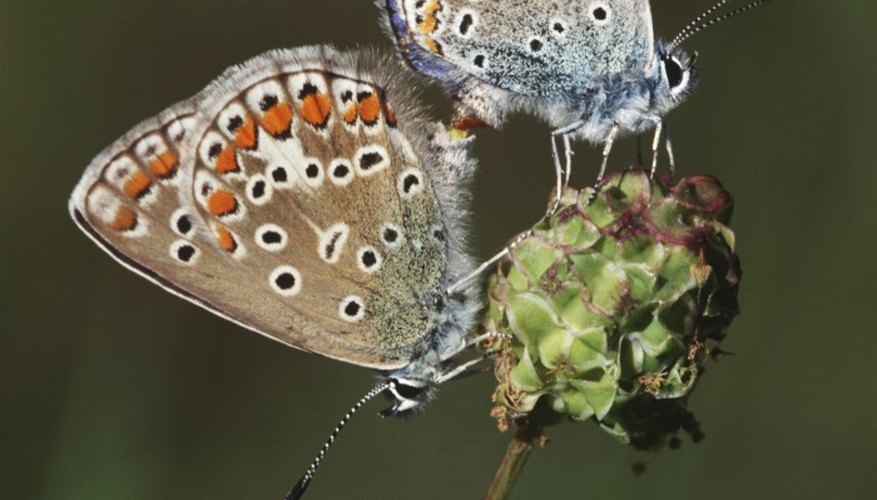Breeding and raising butterflies is a hobby that is as rewarding as it is interesting, and the ability to view the process at close range is indescribable. Raising butterflies can be done at home or in the classroom and provides a learning experience that all age levels can benefit from. While raising butterflies with the intent to release them back into nature is perceived to be the best case scenario for the well being of the butterfly, breeders continue to support the beneficial contributions that the business creates. And those that have ever had a butterfly wedding will agree that butterfly breeders do ultimately release the butterflies back into the environment.
Getting started

Begin by identifying the butterflies that are local to your area. Knowing the different butterfly species available will help you choose which butterflies to breed. Research the butterflies of your choice and learn which food plants you will need to supply them with for their survival. Each butterfly family lays eggs on and feasts on a plant that is unique to that species. For instance, a Monarch exclusively eats milkweed leaves, and a Spice Bush Swallowtail only eats leaves of the spice bush plant.
Know what the butterfly looked like in one of its previous forms. Every butterfly was once a caterpillar, and in order to breed butterflies, you need to start with caterpillars. The caterpillars are larva that have hatched from eggs that a butterfly has deposited on the leaves of the food plant.
Familiarise yourself with the regulations concerning butterfly breeding. It is illegal to collect eggs or caterpillars of a protected species.
Start small by breeding one butterfly at a time in order to dedicate more time to learning about the genus. Butterflies are living things, and delicate guidelines need to be followed to ensure their well being.

Choose a butterfly species and locate its larva or eggs. To do this, observe the butterfly’s food source in your area. For example, if you have decided to breed the Monarch butterfly, you will need to search your local lakes, rivers, woodlands and swamps for milkweed plants. Lift the leaves of each of the plants and look underneath. The caterpillars and eggs are usually hiding underneath.

Collect a few of the larva or eggs in a well-ventilated container. The holes should be small enough so that the caterpillars cannot pass but enough to let air circulate in and out of the container. It is easiest to do this by clipping the leaf itself from the plant, especially if the eggs are on it. You will need the leaves anyway to feed the caterpillars.
Gather a few extra leaves for the caterpillars to eat as they grow. This part is very crucial. In order to grow, the caterpillars need food. The more they eat, the bigger they will get, and the closer they will come to transformation. You will need to continually collect leaves from your caterpillars’ food plant, so the plants should be local or within a close distance for convenience.
- Begin by identifying the butterflies that are local to your area.
- For example, if you have decided to breed the Monarch butterfly, you will need to search your local lakes, rivers, woodlands and swamps for milkweed plants.
- This part is very crucial.
Breeding
Remove the lid of the container that is holding your newly collected caterpillars and eggs and carefully remove the leaves that harbour them. Place a damp paper towel under the leaves to keep them damp. Caterpillars cannot eat leaves that are dry, so change the paper towel every time you check on your caterpillars to keep the leaves moist.
Change the caterpillar’s food daily. If you only have eggs collected, it is OK to leave the same leaves in the container until the eggs hatch. But once the larva appears, fresh leaves should be offered daily.
Clean the container regularly. Once the caterpillars begin to eat, they will also begin to relieve themselves. The more they eat, the more often this happens. The bottom of your container can begin to fill quickly with the caterpillar droppings, so you should clean it up as necessary.
Switch to a larger container when you begin to notice growth. Caterpillars grow very quickly. They shed their outer skin and begin to double in size many times over in a matter of weeks, so it will be necessary to find them more comfortable accommodations. An old fish tank will work perfectly as their new haven, even a tank with a crack.
Add a few sticks for the caterpillars to climb on and continue to add plenty of leaves from the food plant to the tank. You will notice mass amounts of chomping going on in the tank, and the holes in all of the leaves will be proof that your caterpillars are flourishing.
Cover your tank with a wire meshed top to prevent the caterpillars from escaping and make sure that the holes in the mesh are not too big. You can also use cheesecloth stretched over the top of the tank and tightly secured with elastic or string.
Pay careful attention to your caterpillars when they begin to become big and plump. They will eat for about two to three weeks before they begin to show signs that they are ready to begin their transformation. You will begin to notice the caterpillars hanging from one of the branches in the tank, or sometimes the lid. During this time they will once again shed their skin, and this is where the magic begins. Within hours they will become a chrysalis.
Watch your tank closely for the next two weeks. All of the caterpillars will form their chrysalis around the same time, so you will not have to worry about any more feedings. The chrysalises will begin to become transparent, and you will be able to see the butterfly inside. This means that in a few days the butterflies will emerge. Once they do, they will begin their next level of transformation.
Allow the emerged butterflies to fully complete their transformation before you release them from the tank. The butterflies will begin to puff up their wings, and as they do, their wings will begin to dry. Until this process has been totally fulfilled, they are not ready to fly. You will find them ready to exit the tank when flight is attempted.
- Remove the lid of the container that is holding your newly collected caterpillars and eggs and carefully remove the leaves that harbour them.
- You will notice mass amounts of chomping going on in the tank, and the holes in all of the leaves will be proof that your caterpillars are flourishing.
- Once they do, they will begin their next level of transformation.
- You will find them ready to exit the tank when flight is attempted.
Release your butterflies either back into the environment, or if you have decided to keep them to continue the process in captivity, you will need to make provisions prior to this point in their life cycle. A greenhouse or other large enclosed area complete with a growing food source can ensure that your butterflies remain and keep producing under your watchful eye. Otherwise, they will fly away and continue their reproductive process in the great wide open.
TIP
Growing the food plant exclusive to your chosen butterfly species is highly suggested to ensure adequate food sources.
WARNING
Do not give your caterpillars a bowl of water in the tank. The caterpillars can not swim and will drown in the bowl They get all of the water that they need from the moisture in the plant leaves.
If you are raising your butterflies in a tank outdoors, make sure that the tank is in a warm area and completely protected from the elements.
Be careful with the caterpillars around family pets; some of them can be poisonous if they are eaten.
